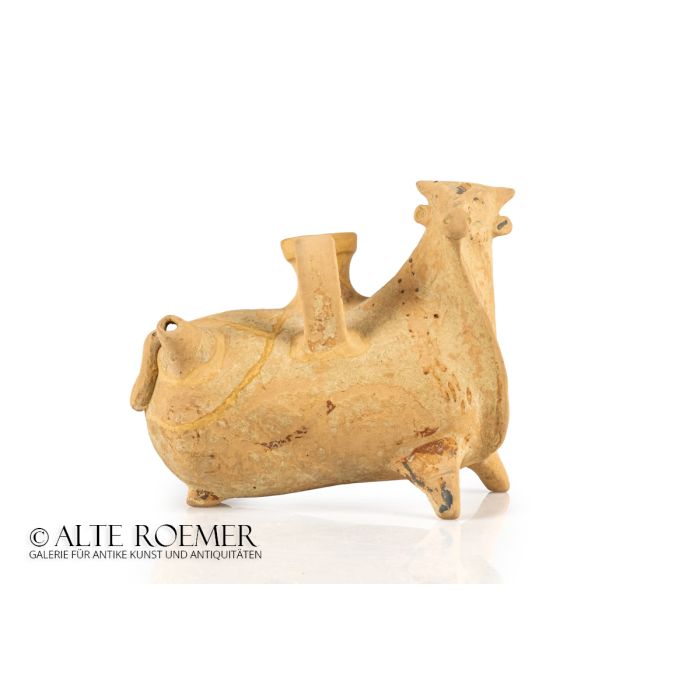Greek bull askos from Sicily
Price: on request
Sold
Object number
AR3268
| Object: |
Greek bull askos from Sicily
|
| Material: |
Orange terra cotta. Remains of beige slip, painted in red and black.
|
| Period: |
450 BC to 400 BC. Classical Antiquity. |
| Description: |
Small clay vessel in the shape of a bull. The body of the so-called askos is almost cylindrical and made on the potter's wheel. The head is realistically modeled and looks to the side. The strongly emphasized skin fold between the throat and the chest gives the appearance of a dynamic head movement. The tail and legs are also modeled by hand. The animal body has a small spout on the side of the body, and a large spout with a handle in the middle of the body. The entire clay vessel was once primed and painted, still recognizable by the double row of dark dots around the neck, the black details on the head and the remains of a more areal black and red painting on the lower half of the body and the feet. |
| Background: |
This Askos-type clay vessel was used to store and dose a liquid, perhaps oil for lamps, spice sauce in the kitchen, or perfume. A use for libations in a funeral context is also conceivable. The vessel type was popular throughout Greece. For this vessel, an origin in Sicily is certain on the basis of comparative finds. The production sites that come to mind are Syracuse and Selinunte. Vessels in the shape of bulls, horses and mice were popular there. It is interesting that the style imitates earlier Corinthian vessels which were best sellers in the Mediterranean. The Sicilian potters obviously wanted to share in this success and therefore expanded the repertoire and further developed the designs of the Corinthian potters.
|
| Dimensions: |
13.4cm long, 6.2cm wide, 11.0cm high.
|
| Condition: |
Body professionally restored from a few fragments, with only minimal additions to the seams and an added remodeled spout on top of the vessel. The vessel as a whole is in very good condition, including remains of the original painting.
|
| Provenance: |
Acquired by us in 2022 from the Swiss private collection of P. Bonsera. Acquired at Hammer auction, Basel, Switzerland, 26 September 2019, lot 72. Previously in the Swiss private collection Bollmann, Zurich. Acquired by Bollmann in 1968 from the dealer Saieva. The find spot passed down is Gela, an ancient city in Sicily, Italy. The place of manufacture is likely another place in Sicily, probably Syracuse or Selinunte.
|
| References: |
The object was part of an identification exercise in the seminar of the Department of Archeology at Zurich University. A copy of a report on the classification of this piece from 1982 is available, prepared by the then seminar lead Dr. Michel Sguaitamatti together with Prof. Dr. Hans Peter Isler, a classical archaeologist who dug in Sicily. Prof. Isler mentions the following comparison pieces in his report: B. Heldring, Sicilian plastic vases (1981), no. 72 series D and 77. A. Adriani, E. Manni, P. Arias, E. Natoli, V. Tusa, Odeon (1971), plate VII, plate XV and plate IIL a. We would also like to point out a very similar piece that Prof. Isler was not aware of at the time. It probably comes from the same Sicilian workshop and is now in the Museum of Fine Arts Budapest, acc. no. 2000.2.A. There you can see what the side painting once looked like on the piece we are offering. |
| Authenticity: |
We unconditionally guarantee the authenticity of every artefact, all items are subject to our lifetime return policy on authenticity.
|


